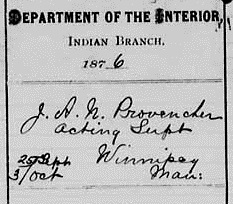Reginald Bagshaw

Du Vernet met Reginald Heber Bagshaw and his wife Clara on an overnight visit to Little Forks on July 14-15. Bagshaw was a lay missionary and teacher at the government school at Little Forks Reserve. The son of an Anglican vicar, Reginald Bagshaw was born in 1869 at Braunstone Vicarage in Leicestershire, England. He was named after Reginald Heber, who was the second Anglican Bishop of Calcutta, India. Bagshaw followed in his namesake’s footsteps and came to Canada in 1893 with the Anglican Church Missionary Society.
Teaching school
Not a priest, Bagshaw was a lay missionary who served as a “Teacher Catechist.” This means that he was paid by the Canadian government to teach Ojibwe (and later Cree) children to read and write while instructing them how to live as Christians. When Du Vernet met Mr. Bagshaw, he was 29 years old and living at Little Forks with his family. Du Vernet tells us that Bagshaw called his pupils to school with a bugle and that he was working with Ojibwe boys to pull up tree stumps to clear land for a future mission. Bagshaw had a determined opponent in this work: an “Indian Woman,” who had opposed the mission pulling up the stakes when the land was marked off.
Joking in Anishinaabemowin
According to the diary, Bagshaw’s Anishinaabemowin was good enough to be able to joke with Ojibwe visitors to his home. In Du Vernet’s view, Bagshaw and Clara appreciated the “time of retreating” and prayer during his visit. Bagshaw left the Rainy River in March 1907, when he moved to The Pas, Manitoba, as a teacher/catechist for Cree children. He retired as a teacher in 1910, and was Postmaster of The Pas from 1912-1942, the year of his death.
Sources
“R.H. Bagshaw Fonds.” Sam Waller Museum, The Pas Community Manuscript Collection.